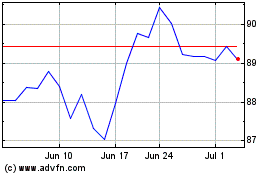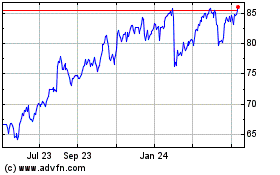Fitch Restates Aflac, Outlook Up - Analyst Blog
April 18 2011 - 1:27PM
Zacks
Fitch Ratings affirmed its credit and insurance strength ratings
on Aflac Inc. (AFL) and its subsidiaries, on
Friday, despite the fact that almost 77% of the company’s
operations are based in Japan, which was struck by devastating
tsunami, earthquake and nuclear reactor disasters last month.
The rating agency has upgraded its outlook to ‘stable’ from
‘negative,’ based on Aflac’s strong credit quality and reduced
exposure to perpetual preferred securities, when compared to its
peer group. Accordingly, the company’s subsidiaries continue to
enjoy 'AA-' insurance financial strength (IFS) rating.
Fitch also maintained its 'A-' rating on Aflac’s long-term
senior unsecured notes that were issued in 2010 -- $300 million
senior unsecured notes due 2015 carrying an interest rate of 3.45%,
and to $450 million senior unsecured notes due 2040 carrying an
interest yield of 6.45%.
In August last year, Fitch assigned an “A-” rating to the
above-mentioned senior unsecured notes, though it tagged a negative
outlook. This was based on the probability of future impairments in
Aflac’s investment portfolio, which can adversely impact its
earnings and capital strength.
Nevertheless, as expected, this was a “could-be-risk” scenario
as Fitch stressed on Aflac’s strong earnings potential in 2010 and
forward, which will help in mitigating risks related to the
constitutional capital and also enhance the company’s statutory
earnings that have already exceeded $1 billion in 2010.
The net proceeds from Aflac’s senior unsecured notes are
projected to be utilized for the full repayment of fixed rate 1.52%
Uridashi notes and variable interest rate Uridashi notes, both due
in September 2011.
Despite challenging economic conditions that have recently
marred the insurance industry in Japan, Aflac continues to enjoy a
modest liquid position. The company’s investments and cash position
is experiencing a steady growth. Cash position increased to $88.2
billion in 2010 from $73.2 billion in 2009, $68.6 billion in 2008
and $57.1 billion in 2007, thereby providing ample operating
leverage to the balance sheet.
Furthermore, Aflac’s National Association of Insurance
Commissioners (NAIC) risk-based capital ratio increased about 76
basis points to 555% at the end of 2010. Going ahead, this strong
capital and surplus position is expected to mitigate balance sheet
risk and provide liquidity cushion to its long-term growth.
With reduced asset impairments that also helped shrink Aflac’s
debt-to-capital ratio to about 23%, Fitch believes that Aflac is
modestly leveraged to absorb its insurance losses in Japan better
than its peers, since the company has minimal operations in the
hardest-hit areas.
While Aflac’s key mortality-based products and cancer-related
products are supposed to be the areas of concern, Fitch remains
confident of the company’s credit quality, which improved modestly
over the last few quarters.
Overall, Aflac has been achieving its earnings target for the
last 20 years, which is reflected in its consistent dividend
increment. Amid nominal economic recovery, Aflac has been able to
improve its expense ratio that resulted in consistent profit margin
expansion.
Once the economy treads on a more stable path, we believe that
the company will be able to gain from the increased client activity
and enhancement of its group product platform, which will be
eventually reflected in the top- and bottom-line growth in 2011 and
beyond.
Aflac primarily competes with Unum Group (UNM)
and Catalyst Health Solutions Inc. (CHSI).
AFLAC INC (AFL): Free Stock Analysis Report
CATALYST HEALTH (CHSI): Free Stock Analysis Report
UNUM GROUP (UNM): Free Stock Analysis Report
Zacks Investment Research
AFLAC (NYSE:AFL)
Historical Stock Chart
From Jun 2024 to Jul 2024

AFLAC (NYSE:AFL)
Historical Stock Chart
From Jul 2023 to Jul 2024
